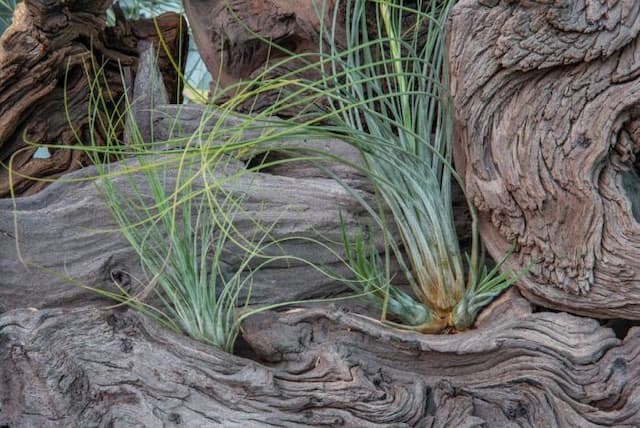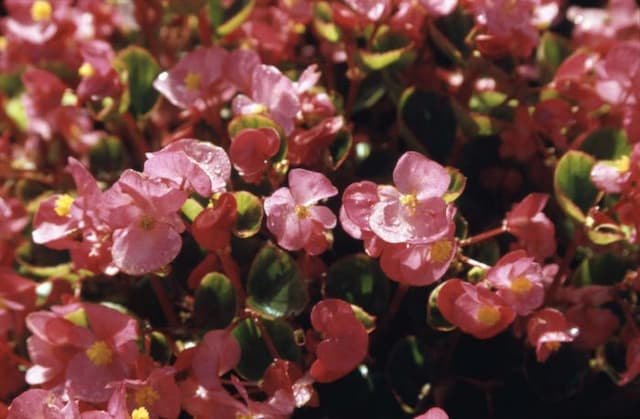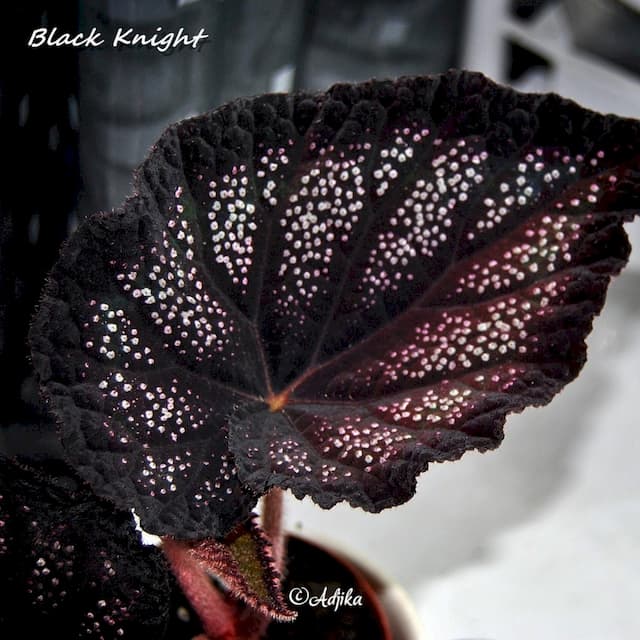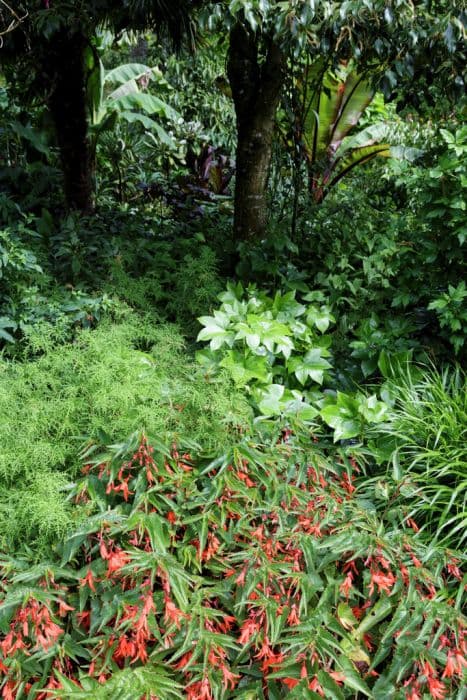Illumination Begonia Begonia Illumination Series (T/d)

ABOUT
The Begonia Illumination Series (T/d) is noted for its profuse and cascading flowers that create a stunning display throughout its growing season. The plant's foliage is typically lush and glossy, providing a vibrant green backdrop that accentuates the vivid color of its blooms. The flowers themselves boast a range of hues, such as vibrant reds, pinks, oranges, yellows, and whites, often with multiple shades on a single plant. The blossoms are double or semi-double, giving them a full and rounded appearance, resembling little rosettes. While I can't mention specific dimensions, these plants are known for their robust and trailing growth habit, making them ideal for hanging baskets or containers where their foliage and flowers can spill over the edges in a dramatic floral cascade.
About this plant
 Names
NamesFamily
Begoniaceae
Synonyms
Illumination Begonia, Trailing Begonia
Common names
Begonia x tuberhybrida 'Illumination Series'
 Toxicity
ToxicityTo humans
Begonias, including the Begonia Illumination Series, are considered mildly toxic to humans if ingested. The main component causing toxicity is the soluble calcium oxalates present in all parts of the plant. If a person were to chew or swallow parts of the plant, they might experience symptoms like irritation of the mouth, lips, throat, and tongue, as well as difficulty swallowing, and stomach upset. In more severe cases, it can cause vomiting. Handling the plant may also cause skin irritation in some individuals. It is advisable to keep begonias out of reach from children who might accidentally ingest parts of the plant.
To pets
Begonias, including the Begonia Illumination Series, are also toxic to pets, such as dogs and cats. The toxicity is due to the soluble calcium oxalates contained in the plant which, when ingested, can cause irritation in the mouth, tongue, and lips, excessive drooling, difficulty swallowing, and vomiting. In severe cases, it could cause inflammation of the gastrointestinal tract. Pet owners should prevent their animals from chewing on or ingesting any part of the plant to avoid these adverse effects.
 Characteristics
CharacteristicsLife cycle
Annuals
Foliage type
Deciduous
Color of leaves
Varies
Flower color
Varies
Height
1-2 feet (30-60 cm)
Spread
1-2 feet (30-60 cm)
Plant type
Herb
Hardiness zones
10
Native area
Tropical and Subtropical regions
Benefits
 General Benefits
General Benefits- Enhanced Aesthetics: Begonias in the Illumination Series are prized for their vibrant and cascading flowers, which add a splash of color to gardens, patios, and balconies.
- Low Maintenance: These plants are relatively easy to care for, requiring minimal maintenance, thus suitable for both novice and busy gardeners.
- Continuous Blooming: They are known to bloom from spring through fall, providing a long season of visual interest.
- Adaptability: Begonias can thrive in a variety of lighting conditions, from partial shade to full sun, which makes them versatile for different garden settings.
- Drought Tolerance: Once established, they are quite tolerant to brief periods of drought, reducing the need for constant watering.
- Habitat for Wildlife: The flowers of Begonias can attract beneficial insects and pollinators like bees and butterflies to the garden.
- Variety of Uses: Suitable for hanging baskets, containers, and window boxes, they offer flexible design options for urban and small-space gardening.
- Tolerance to Heat: These plants can perform well in warm climates, making them a good choice for summer gardens.
 Medical Properties
Medical PropertiesThis plant is not used for medical purposes.
 Air-purifying Qualities
Air-purifying QualitiesThis plant is not specifically known for air purifying qualities.
 Other Uses
Other Uses- Photography Subjects: The Begonia Illumination series, with their vibrant colors and varied forms, can provide an excellent subject for macro photography, showcasing the intricate details of the flowers.
- Educational Tools: These plants can be used in botanical studies and educational workshops to demonstrate plant growth, hybridization, and care practices.
- Art Inspiration: Artists may use the striking appearance of these begonias as inspiration for paintings, drawings, or textile designs.
- Event Decorations: Due to their showy blooms, these begonias can be used as decorations in weddings or other events, either as potted plants or in floral arrangements.
- Bonsai Creations: With careful pruning and training, Begonia Illumination can be cultivated as part of a bonsai garden for an unusual display.
- Culinary Garnish: Although not commonly consumed, the flowers can occasionally be used as a decorative, non-toxic garnish for culinary dishes.
- Crafting: The stems and flowers could be used in crafting, for making natural dyes or in pressed flower arrangements.
- Color Therapy: These begonias can be utilized in color therapy sessions, as their bright colors are believed to influence emotions and mood positively.
- Animal Enrichment: Safe for certain animals, these plants might be included in habitats to provide environmental enrichment and stimulate natural behaviors.
- Seasonal Displays: The begonias can be featured in seasonal garden displays to create a visually appealing theme, especially in the summer and autumn when they are in full bloom.
Interesting Facts
 Feng Shui
Feng ShuiThe Begonia is not used in Feng Shui practice.
 Zodiac Sign Compitability
Zodiac Sign CompitabilityThe Begonia is not used in astrology practice.
 Plant Symbolism
Plant Symbolism- Caution: Begonias can symbolize a sense of caution or warning. This comes from the way their flowers hang, which can be reminiscent of someone bowing their head in thoughtfulness or caution.
- Gratitude: Offering Begonia flowers to someone can be a sign of your gratitude or appreciation for them.
- Individuality: Due to the vast variety of Begonias, including the Illumination series, they can symbolize uniqueness and individuality, encouraging one to stand out from the crowd.
- Harmony: The balanced and symmetrical nature of Begonias’ growth patterns and blooms can represent harmony and a peaceful environment.
 Water
WaterThe Begonia Illumination Series, commonly known as "Illumination Begonia," prefers to be watered thoroughly, and the soil should be allowed to dry slightly between waterings. Water the plant approximately once a week, but this can vary based on temperature and humidity conditions. When watering, apply enough water so that it begins to run out of the pot's drainage holes, suggesting that the soil is fully saturated. On average, this usually amounts to about 16 ounces for a standard 6-inch pot. It’s important to avoid letting the plant sit in water, as this can lead to root rot.
 Light
LightIllumination Begonia thrives in bright, indirect light. Direct sunlight can scorch the leaves, while too little light can cause leggy growth. A spot near an east-facing window where soft morning light filters in is ideal for this plant. Alternatively, the plant can do well under fluorescent plant lights if natural light is not sufficient.
 Temperature
TemperatureThe ideal temperature conditions for the Illumination Begonia range from 60 to 75 degrees Fahrenheit. It should never be exposed to temperatures below 50 degrees Fahrenheit, as cold temperatures can be detrimental to the plant. Consistently warm temperatures will support robust growth, while fluctuations in temperature should be minimized to prevent stress.
 Pruning
PruningPruning the Illumination Begonia helps to maintain its shape and encourage bushier growth. Trim back leggy stems and remove any dead or yellowing leaves to improve the plant's appearance and health. The best time for pruning is in the spring before the new growth starts. Pruning can be done as often as needed to keep the plant looking tidy.
 Cleaning
CleaningAs needed
 Soil
SoilThe best soil mix for the Begonia Illumination Series, commonly known as trailing begonias, should be light, rich, and well-draining. A mixture containing equal parts peat, perlite, and pine bark is suitable. The soil pH should be slightly acidic to neutral, between 5.5 and 7.0.
 Repotting
RepottingTrailing begonias from the Begonia Illumination Series should be repotted every one to two years, or when the plant outgrows its container. The best time for repotting is during the spring or early summer.
 Humidity & Misting
Humidity & MistingTrailing begonias thrive in moderate to high humidity levels, ideally around 50% to 60%. They benefit from a humid environment but should not be misted directly to prevent leaf and stem diseases.
 Suitable locations
Suitable locationsIndoor
Place in bright, indirect light and away from drafts.
Outdoor
Keep in partial shade, protect from wind and harsh sun.
Hardiness zone
10-11 USDA
 Life cycle
Life cycleThe life cycle of the Begonia Illumination Series begins with the germination of seeds in a warm, moist environment, which usually takes a few weeks. After germination, the seedlings grow into juvenile plants, developing a rosette of leaves and a strong root system. As they mature, they enter a vigorous vegetative growth stage, where lush, cascading foliage and blooms develop over time. Throughout the growing season, the plants produce a profusion of colorful flowers that are often used in hanging baskets and containers. To ensure continued growth, regular feeding and pruning are necessary, particularly during the flowering season. After flowering, begonias can be propagated through cuttings or division, allowing new plants to begin the cycle again, while the original plant eventually enters a period of dormancy, especially in cooler climates.
 Propogation
PropogationPropogation time
Spring-Summer
Begonias from the Illumination Series are typically propagated through stem cuttings, a popular method due to its high success rate and the relative ease with which it can be done. To propagate these begonias, a healthy, non-flowering stem is chosen. A cutting of about 3 to 4 inches (approximately 7.6 to 10.2 centimeters) is taken with a clean, sharp pair of scissors or a knife. The cut should be made just below a leaf node, as this is where the new roots will form. The lower leaves are removed, and the cutting is placed in a moist, soilless potting mix or directly into water. Within a few weeks, the cutting should develop roots and can then be transplanted into a pot with regular begonia soil mix. It's best to propagate these plants in the spring or early summer when they are actively growing, which ensures a quicker and more successful rooting process.

![Begonia [Allure]](/_next/image?url=https%3A%2F%2Fplants-admin.emdemapps.com%2Fimages%2Fplants%2F%2Fimages%2F604b5b9006ab9.png&w=640&q=75)







